Real Food Kitchen Tour: The Okparaeke Family
Welcome to another edition of the Real Food Kitchen Tour. This week we’re featuring Charlotte Okparaeke and her family who live in London and cook a lot of traditional West African food.
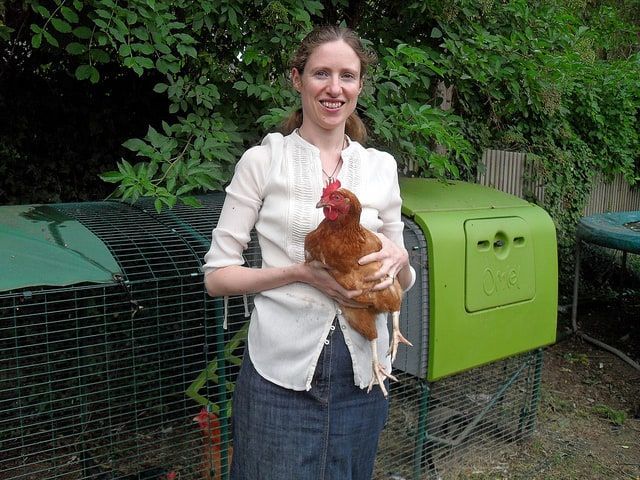
Welcome to another edition of the Real Food Kitchen Tour. This week we’re featuring Charlotte Okparaeke and her family who live in London and cook a lot of traditional West African food.
What’s a Real Foodie?
A “real foodie” is someone who cooks “traditional” food. We cook stuff from scratch using real ingredients, like raw milk, grass-fed beef, eggs from chickens that run around outdoors, whole grains, sourdough and yogurt starters, mineral-rich sea salt, and natural sweeteners like honey and real maple syrup.
We don’t use modern foods that are either fake, super-refined, or denatured. This includes modern vegetable oils like Crisco and margarine, soy milk, meat from factory farms, pasteurized milk from cows eating corn and soybeans, refined white flour, factory-made sweeteners like HFCS or even refined white sugar, or commercial yeast.
We believe in eating wholesome, nutrient-dense foods that come from nature. So we shop at farmer’s markets or buy direct from the farmer, or we grow food in our own backyards.
This Week’s Real Food Kitchen Tour: The Okparaeke Family
This week I’m featuring Charlotte Okparaeke who lives in London with her family. Her husband is from Nigeria, and they cook a lot of traditional African food.
I asked Charlotte to share a bit about traditional Nigerian cooking. This is what she wrote:
African food is big on soups and stews. The whole animal is used, even the bones are chewed right down. When I first went to Nigeria they thought I was very wasteful in not eating all the meat, soft tissues and cartilage and leaving this and the bones uneaten on my plate. I have learned to enjoy all of this now.
The classic starter is Pepper Soup which is a collection of fatty meats usually including tripe and intestine cooked in a clear broth with a special mix of spices. This is usually followed by a ‘soup’ which is more of a stew consisting of a mixture of meats (goat is popular) and quite likely fish as well, the fish may be dried (sometimes smoked) or fresh. Ground shellfish may also be added, e.g. shrimp and crayfish.
The soups have local spices and herbs added and often have some green leaf vegetable in them as well. The popular egusi soup is thickened with ground ‘egusi’ which is a type of melon seed. The soup is red in colour as plenty of palm oil is added. Palm oil, which is highly nutritious is the traditional cooking oil. Sadly, imported vegetable oil is nowadays widely available and a popular substitute. The soup is eaten with pounded yam or cassava. This stiff starchy side dish is moulded into a ball in your hand and dipped into the soup (no knives and forks!).
The traditional ‘seasoning cube’ is called ogiri. It is made from fermented melon seed (ground egusi) and cutely packaged in dried leaves. The smell (when unwrapped) is reminiscent of a strong cheese or miso. It lasts a long time, you will see some hanging up in my kitchen above the stove. It upsets me greatly that in many cases these type of seasonings are being replaced by MSG laden seasoning cubes such as Knorr or Maggi by Nestle.
Babies are typically weaned onto ‘pap’ or Ogi which is a fermented porridge made with millet or maize (it’s not just a baby food; adults eat it too). I am more familiar with the maize version which is a bit like custard but has a sourer taste. You can find the recipe (using millet) in both Nourishing Traditions (p.459) and Wild Fermentation (p.117) cookbooks. Of course Nestle have brought out their own low nutrient version of pap called Cerelac. Nestle is BIG in these developing countries, bringing out cheap and nasty imitations of nutritious local foods. Since they are a large and well established company, their products are popular and trusted. Well, it is of course what has already happened all over the western world, cheap processed foods replacing nutritious local traditional foods.
Black eye beans are another popular food which has many variations in the way it is prepared. See below for a sample recipe.
There are no desserts that I am aware of, but plenty of delicious tropical fruits including mango, oranges, banana, soursop (custard apple) and many more, some of which I’ve never seen outside of Africa. Some snack foods that are widely available are roasted corn on the cob, roasted groundnuts (peanuts – much tastier than KP and not coated in vegetable oil and salt), boiled egg, fruits, fresh or dried coconut, and ‘suya’ — a barbecued kebab of seasoned meats threaded onto a skewer. This may be dehydrated and would then be rather like jerky.
It is hard to think of a recipe to share as so many of the ingredients and preparation techniques will be strange to people in US/Europe and you might only find them at specialist African stores. Even now I don’t know what many ingredients are as DH only knows the local names for them and I do not know if there are English names/equivalents.
Here is a great website however with lots of tutorials for West African delicacies. The recipe I’m linking too is for a delicious snack or side dish called moi-moi. It goes very well with a salad of lettuce and tomato. Not all the ingredients on this website are ‘real food’ so make your own adaptations if you try anything. Corned beef is optional in moi moi and my favourite addition is boiled egg (see comments). Anyone adventurous enough to delve into African cuisine will find some lovely things to try on this site.
Thank you so much, Charlotte! That was fascinating! I know that folks out there will enjoy reading about African cuisine as much as I did.

Blog Name: I don’t have a blog! I don’t feel I could find the time. If I did I would share grain free recipes as I love experimenting in the kitchen and converting recipes to fit with our diet choices, maybe one day. Meanwhile hats off to all you ladies who do have helpful and inspirational blogs.
Me:Charlotte Okparaeke, wife to Kevin and mum to 14-year-old DD and DS1 13, DS2 11, and DS3 3yrs.
Location: South East London, UK
House or Apartment: House
Size of Kitchen: If I could find a tape measure I’d tell you, it’s a very reasonable size as it doubles as a diner (we don’t have a separate dining room) and it’s oblong in shape.
Things You Love About Your Kitchen: I love the size, the light coming from the windows, my hanging rail for utensils, my shelf for recipe books, the sturdy kitchen table, scars and all, I could go on….
Things You Would Change: Well it would be nice if the sink actually looked out into the garden, also I would rather like to extend my kitchen into the utility area (by the back door) and be able to walk straight into the garden.
Favorite Tools & Gadgets: My big kitchen knife, Vitamix, Excalibur dehydrator, Pyrex jugs, juicer.
Biggest Challenges Cooking Real Food: Keeping up! Feeding a family of six without relying on convenience foods certainly keeps you on your toes. Currently we are transitioning onto the GAPs diet as my 11year old son has autism and most of us have some issue or another that we hope the GAPs diet will help with. So even more of a challenge.
Current Family Favorite Meal: The kids love the typical kids favourites: spag bol, meatballs, burgers, etc. All these can be made healthily and I sneak in organ meats such as liver and heart, and hide lots of veggies in the sauce. We all love the West African dishes from Eastern Nigeria where DH comes from. They eat ALL parts of the animal in their cuisine, and ferment and prepare everything properly.
Favorite Cookbooks: Just like mother used to make by Tim Norrington-Davies, Levi Roots’ Reggae Reggae Cookbook, Red Velvet & Chocolate Heartache by Harry Eastwood. I also have files full of recipes from my favourite blogs, most recently I have a file full of recipes from the Reversing Food Allergies online cooking class which I have just completed, and I’m making lots of things from there.
Here are some photos of Charlotte’s kitchen (with her comments in and quotes and mine not in italics):
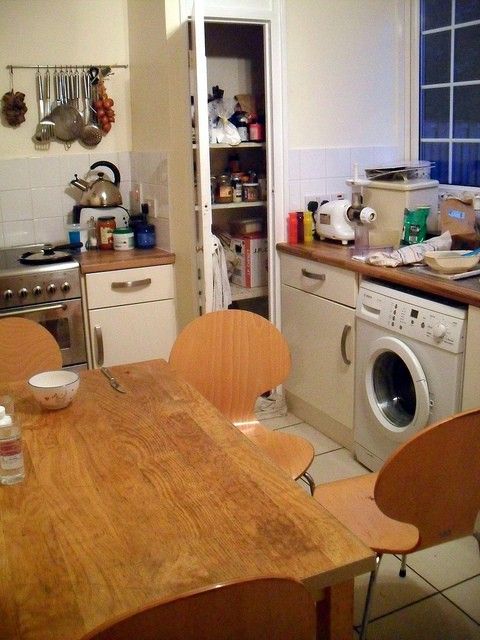
“We have a larder in the far corner which is great for storing much of our foodstuffs.”
Love the kitchen and chairs! Your kitchen is small (by American standards anyway) but it looks super-functional and I love the modern look.
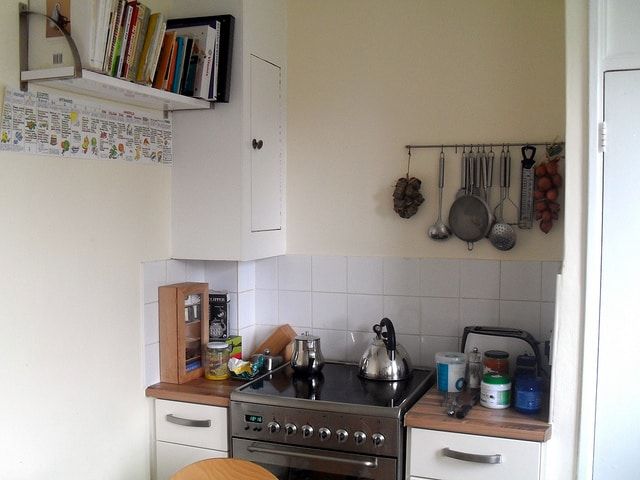
“Probably my favourite part of the kitchen. I love my hanging rail, little tea cupboard (I’m English; I have about 10 different varieties of tea in that corner) and my whistling hob kettle. In front of the tea cupboard is an almost finished jar of ghee. I get Berkeley Farm butter from Abel and Cole (for those in the UK). It’s such a rich colour and makes the most amazing orange ghee. Just looking at the colour makes me happy. We get through a jar or 2 a week. The white corner cupboard just houses the gas meter.”
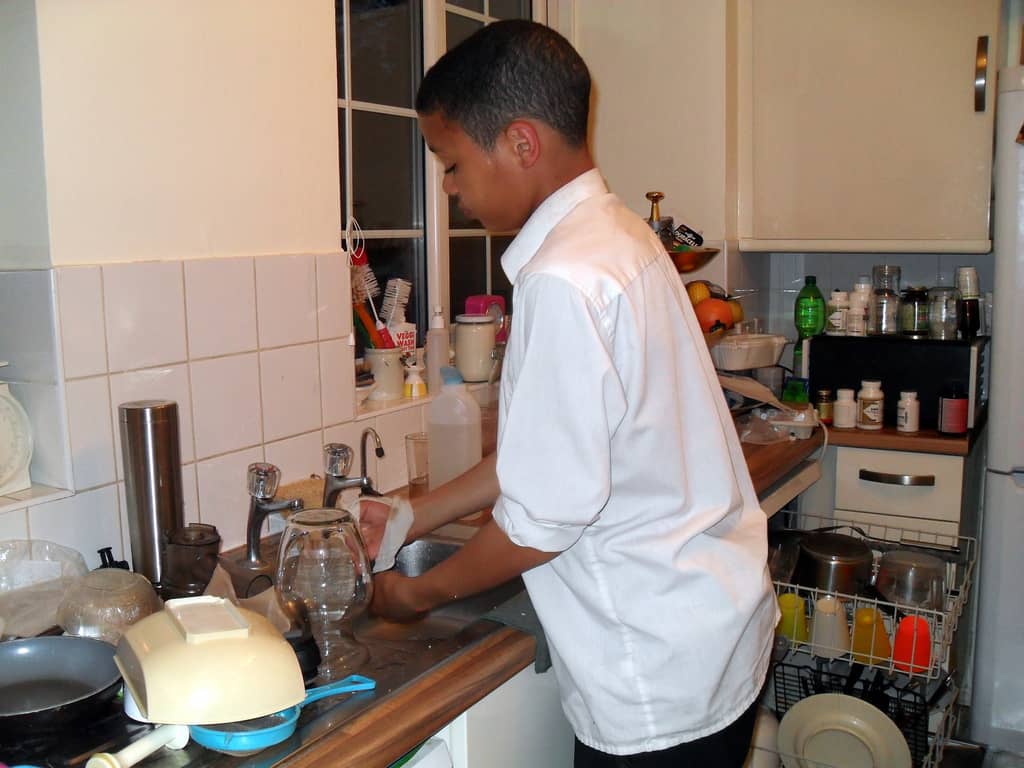
“My son’s turn to clean up the kitchen.”
Ahhh… I can’t wait until my daughter is old enough to do chores! I’m thinking maybe I should start now with easy things… she is 4.
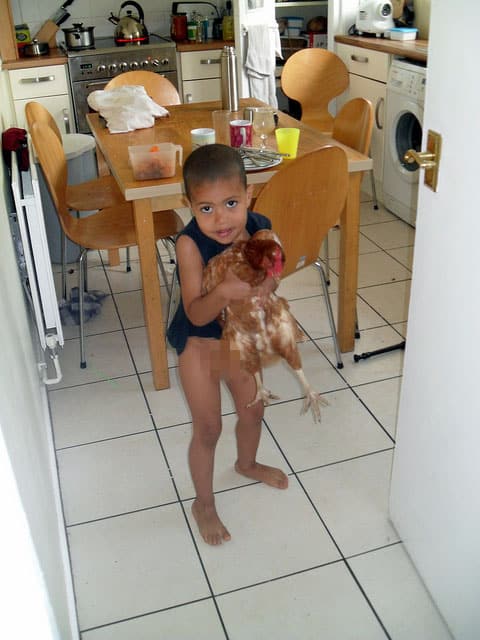
“Chickens do not belong in the kitchen so out they must go.. (My son doesn’t generally choose to wear clothes around the house so since these pics are being posted online I have blurred out as appropriate). The juice pulp in a pot on the table will go to the chickens today. Sometimes I save it and use in baking.”
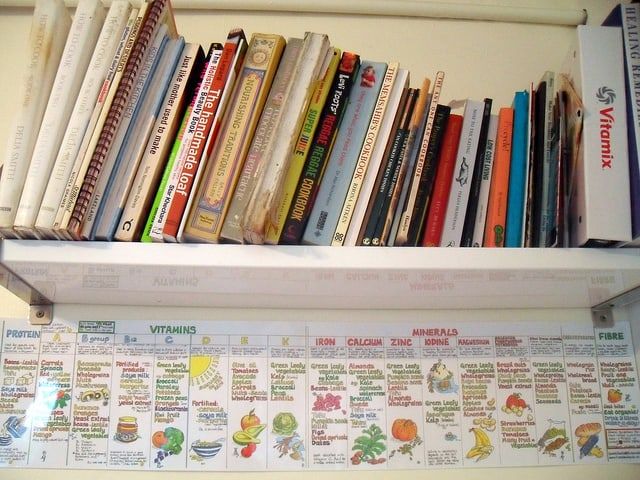
“My husband put this shelf up for me a few weeks ago. Very handy!”
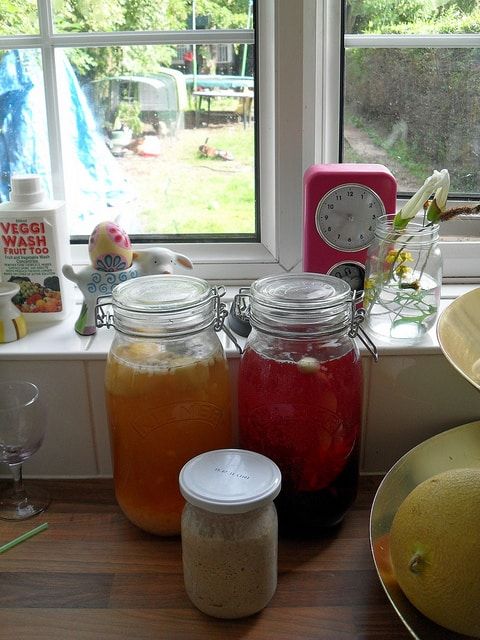
“Looking out into the garden (you can just about see the chicken coop and trampoline in the background). Various ferments on the worktop.”
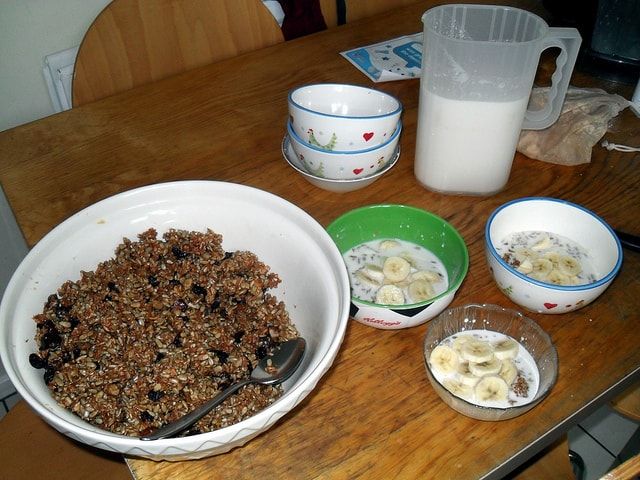
Yay! So excited to see one of our recipes from the Reversing Food Allergies class. What a beautiful breakfast! Can I post this photo on our new Reversing Food Allergies Facebook page?
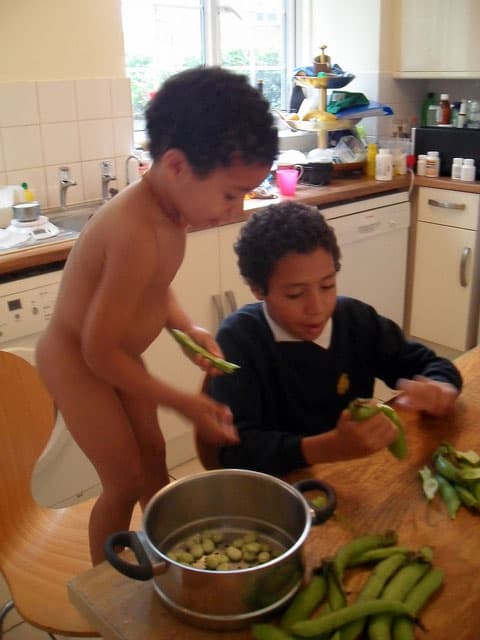
Your sons are adorable!
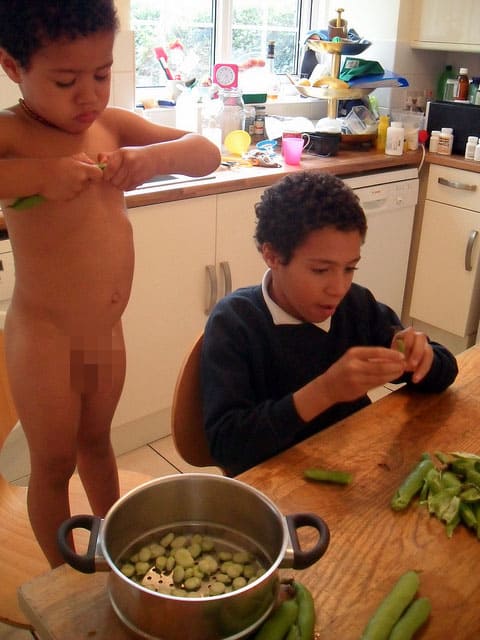
“‘…and the broad beans are sleeping in their blankety beds’, well not any more as my little guys are helping to pop them out ready to cook them for dinner.”
Check Out the Previous Real Food Kitchen Tour Posts
Real Food Kitchen Tour: Holistic Kid
Real Food Kitchen Tour: Artistta
Real Food Kitchen Tour: Nourished & Nurtured
Real Food Kitchen Tour: May All Seasons Be Sweet to Thee
Real Food Kitchen Tour: The Horting Family
Real Food Kitchen Tour: Hybrid Rasta Mama
Real Food Kitchen Tour: Granola Mom 4 God
Real Food Kitchen Tour: Real Food Devotee
Real Food Kitchen Tour: Real Food Forager
Real Food Kitchen Tour: The Leftover Queen
Real Food Kitchen Tour: Health Home & Happiness
Let Us Tour Your Kitchen
Are you a real foodie? Do you have a kitchen that you’d like to see featured on CHEESESLAVE?
Please email me at annmarie AT realfoodmedia dot com. Either send me a link to a Flickr set or email me your photos (minimum of 5, but more is better). Note: Please send me LARGE photos. Minimum 610 width. If they’re too small, I can’t use them.
Oh, and please send the answers to the above questions (at the very top of this post).
As much as I’d love to include all the photos I receive, I can’t guarantee that I will use your photos in the series. I’m looking for creative, good quality photos.
Some ideas for photos:
- Show us what’s in your fridge or what’s fermenting on your counter
- Take some snaps of some of your favorite kitchen gadgets, or show us how you organize your spices
- Got backyard chickens? Send some pics!
- How about a lovely herb garden?
- Kids or pets are always cute!
- Try to include at least one photo of yourself, ideally in your kitchen
And no, you don’t have to have a blog to be included in the tour.
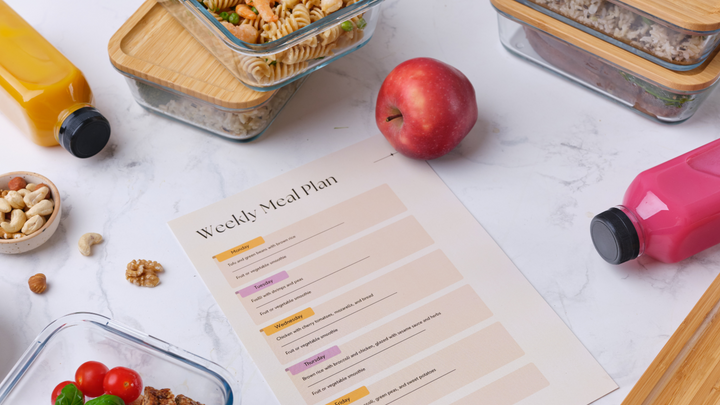
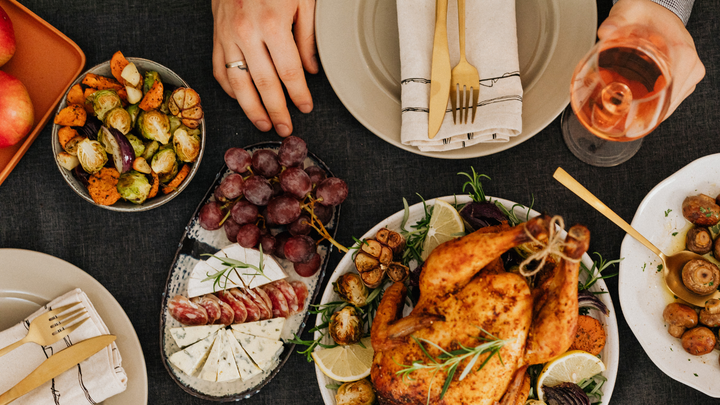
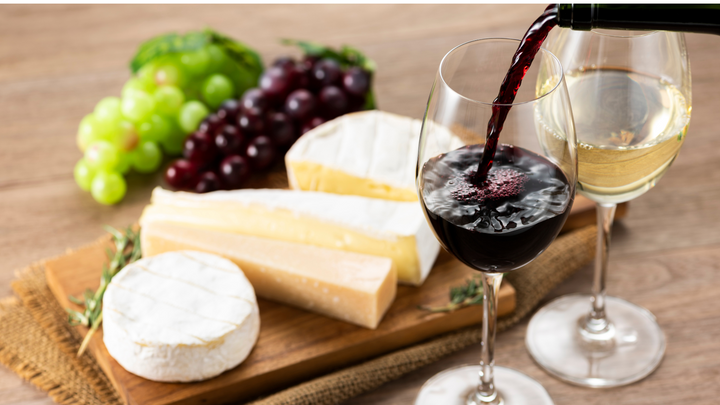
Comments ()